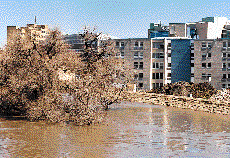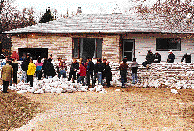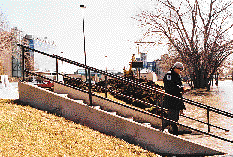Hospital evacuated, mental-health issues dominated as Manitoba coped with flood of century
David SquareCMAJ 1997;156:1742-5
[ en bref ]
David Square is a freelance writer living in Tyndall, Man.© 1997 David Square
In briefIt could be months or even years before the health consequences of this spring's spectacular flooding in Manitoba are fully known. As public-health officials watched for the presence of water-borne pathogens in the swollen Red River, mental-health experts helped 28 000 evacuees cope with the challenges presented by the "Red Sea."
En brefIl pourrait s'écouler des mois, voire des années, avant que les conséquences pour la santé des inondations spectaculaires du printemps au Manitoba soient pleinement mesurées. Alors que les responsables de la santé publique analysaient les eaux de la rivière Rouge pour détecter les agents pathogènes, des spécialistes de santé mentale aidaient les 28 000 évacués à surmonter les difficultés que la «Mer Rouge» leur a laissées sur les bras.
It may be months before Manitobans can clearly judge the impact that the greatest flood in 150 years has had on their homes and their health. For the last 2 months Canadians and Americans living in the Red River Valley battled the rising water as the rest of the continent watched in awe and sympathy. As the floodwaters receded, the battle-weary stepped back to witness what nature had wrought.Although flood damage is often estimated in terms of dollars and property loss, health concerns were also near the top of the agenda. Officials say public-health issues related to water-borne pathogens and infectious disease, as well as the psychological impact of evacuation, loss, crisis and stress, are of significant concern.
Mental-health issues
The psychological impact of Manitoba's flood of the century will be hard to assess for some time, mental-health experts say. They say many of Winnipeg's 650 000 residents will have to deal with some postcrisis stress, but the estimated 28 000 Manitobans evacuated from their homes will be most affected. Their lives were put on hold as the floodwaters slowly rose and then abated. Some returned to find their dwellings in shambles and possessions ruined, and many farmers lost crops.Dr. Keith Hildahl, president of the Manitoba Psychiatric Association and clinical director of the Manitoba Adolescent Treatment Centre in Winnipeg, said post-traumatic stress disorders such as depression and anger can take up to 3 months to appear after a natural disaster.1
"People were evacuated from towns all along the Red River, [and some] have lost their homes and most of their belongings," said Hildahl, "and they are returning home to face the largest clean-up in Canadian history." He added that nearly 50% of rural Manitoba homes that lay outside permanent dikes were ravaged by the flood.
He warned that stressful events can play a causal role in the development of behavioural disorders in children, for boys and girls may both show an increase in aggressive behaviour and enuresis. "At least one study suggests that the degree of household destruction and danger is not as likely to contribute to post-traumatic stress in children as is the overall disruption and terror experienced by the population as a whole," Hildahl said.2

Water laps at the dike protecting the McEwen Psychiatric Centre behind the St. Boniface General Hospital. Before the Red River crested in May volunteers raised the dike from 24.5 feet to 26.5 feet.
Seniors cope better emotionally than younger persons, but they have more difficulty with the physical problems of clean-up and repair, said Hildahl, citing earlier research.3 The same study noted that the elderly are sensitive to the stigma attached to welfare payments and may turn down assistance programs perceived as charity.
"Our best advice to flood victims is to be supportive of each other and to be sensitive to the needs of children. It is important to reassure youngsters that although some things in their lives will have changed forever, there will be an end to the crisis."
He added that some people will feel sad, irritable, angry, discouraged and worried about the future, but these are the normal reactions of people who have experienced a stressful situation.
Dr. John Guilfoyle, Manitoba's chief medical officer, said the province devised a number of strategies to help people, especially evacuees, cope with the flood. Teams of psychologists and nurses were on hand at each community as the floodwaters receded and residents returned home. Two of the hardest hit communities were Ste. Agathe and Grande Pointe, small towns south of Winnipeg where most homes were under water. In conjunction with the province's Emergency Management Organization, pamphlets that explained how to clean and restore a flood-damaged home and resolve the psychologic stresses were distributed. "Stress lines" were also available, including one operated by the Klinic, a community health centre funded in part by Manitoba Health.
Gord Favelle, a psychologist and program specialist with the government's Mental Health Branch, is overseeing the teams offering counselling services. "We can't really estimate what the [long-term] psychological impact of this disaster will be, but at least we're prepared to deal with problems when they arise," he said. "They can't expect to undo all the damage caused by the flood in a single day. We've told them to take breaks, eat well and get lots of sleep."
Public-health issues
Physicians' public-health concerns ranged from worry about the safety of the water supply to advising people in contact with floodwater to have a tetanus booster. However, as the disaster unfolded specialists estimated the threat of infection from water-borne pathogens was only low to moderate.Dr. Robert Brunham, head of medical microbiology and infectious diseases at the University of Manitoba, said major problems had not materialized but vigilance was needed because the Red River may not return to near-normal levels until July. "I have been told it took a month after the flood of l950 for polio to become a serious health problem in Manitoba. We may not have seen the worst yet."
In 1997, experts are more worried that bacteria such as E. coli, Salmonella and Cryptosporidium will enter the food and water supply. Polio and typhoid are no longer prevalent, said Brunham, and it is "extremely unlikely we will experience a problem."
Winnipeggers were advised that their water supply was free of Cryptosporidium. "Since Winnipeg's water comes from Shoal Lake, about 180 km east of the city," said Dr. Margaret Fast, the city's medical health officer, "it is unlikely to be infected by pathogens from flood water." However, residents were advised that people with suppressed immune systems should boil drinking water vigorously for 1 minute as a precaution against microbes and parasites.

Thousands of volunteers erected sandbag dikes around homes in flood-threatened areas of Winnipeg such as the suburb of St. Norbert.
Dr. Jim Popplow, the province's environmental medical officer of health, said similar advice was being given to rural residents whose wells and cisterns may have been contaminated by floodwater. "We have instructed rural evacuees who are re-entering their homes to obtain drinking and cooking water from another source, such as bottled water or an uncontaminated public system," he said. Those unable to get sufficient potable water this way were warned to boil water for up to 3 minutes or to disinfect it with chlorine bleach or other chemicals until water samples could be tested.
Initially officials also were concerned about rotting animal carcasses -- by late April almost 800 had been removed around Grand Forks, the North Dakota city devastated by the flood and a major fire.
However, Popplow said stories of thousands of floating carcasses on the American side of the border were apparently untrue. "There were reports that many American farmers did not have time to move their livestock to higher ground before the flood swamped their land and many of their animals were swept away by the river."
Even if the stories were true, the potential health problems would be countered by frigid water temperatures. "The temperature in the river is about 5 to 7 degrees, about the same as a refrigerated meat locker," said Popplow.
Dilution because of the quantity of water in what became known as the "Red Sea" also helped allay serious health concerns. Even though more fecal material and chemicals such as pesticides entered the river, the water stayed comparatively clean simply because of its volume. "The water is clean enough [in terms of bacterial count] to swim in while pesticides, heavy metal and herbicides are present only in minute amounts," said Popplow. A water sample taken near the border town of Emerson indicated that 2,4-D was just at the detection limit.
As a precaution, Guilfoyle said, people who cut themselves while in contact with river water were being advised to get a tetanus booster unless they had received one within the last 10 years. He was more concerned about the long-term effects of mould and fungi growing in the walls of flooded homes. To reduce the risk of allergy or respiratory infection, people were told to remove wallboard well above the water line.

A security guard stands on a stairway to nowhere to take a water level reading behind St. Boniface General Hospital. The stairs normally lead to a walkway that follows the Red River.
Hospitals coped
As rural Manitobans began to go back to their homes and Winnipeggers watched water levels fall, most of the patients and staff of the St. Boniface General Hospital settled in for what was expected to be a lengthy exile from their facility.About 350 patients were evacuated from the St. Boniface General Hospital to the Health Sciences Centre (HSC) in late April when floodwaters threatened the institution, which was built close to the banks of the Red River and has an extensive tunnel system that is vulnerable to flooding.
Hélène Vrignon, a spokesperson, said the first patients evacuated were from the McEwen Psychiatric Centre, the building closest to the river and most at risk of flooding. A temporary sandbag dike built behind the centre was replaced by a permanent earth dike.
As the river approached its crest in early May, all but about 150 of the hospital's 500 patients were evacuated to the HSC, including those in the neonatal intensive and intermediate care nurseries and the adult intensive care units. Officials said they could evacuate the remaining patients in the projected 40 hours' warning time if necessary. Physicians and support staff moved to the HSC with their patients. By May 11 -- much earlier than expected -- patients and equipment began moving back. Two days later, operations were all but back to normal.
The initial transfer required some adjustments: elective surgery was cancelled and most dialysis patients were referred to the HSC, while obstetric patients were sent to either the HSC or Victoria General Hospital.
Jim Rodgers, assistant to the president of the HSC, said the increased patient and staff load caused remarkably few problems. "Everyone is pitching in and making the best of a difficult situation," he said in early May. "The doctors and nurses from St. Boniface are working shoulder to shoulder with the HSC staff and everyone is getting along just fine."
A parking lot close to the hospital was converted into a landing pad for helicopters required to evacuate patients out of flood zones.
By mid-May, only a few serious cases had been attributed to the flood. "An army corporal had a hand amputated after he touched a live wire, one heart-attack patient died in hospital after he was evacuated by helicopter, and we've handled a couple of hypothermia cases," Rodgers said. "The worst tragedy was the death of a teenager who climbed into a sewer and was swept away by floodwater."
Emergency department physicians treated some sandbaggers who developed repetitive-strain injuries. "I guess this isn't surprising when you consider about 6.5 million sandbags have been used to build temporary dikes," Rodgers said.
Dr. Paul Bradford, a military physician with the Royal Canadian Dragoons, said 7500 military personnel were sent to Manitoba to help deal with the flood. "My field hospital is here primarily to treat army personnel, but we do have helicopters available to evacuate seriously injured civilians," commented Bradford, one of 125 members of 2 Field Ambulance from Petawawa, Ont.
The hospital, complete with army tents, was set up in a hockey arena in St. Andrews, 16 km north of Winnipeg. In the absence of medical emergencies the hospital personnel distributed sandbags and helped construct dikes.
Winnipeg Mayor Susan Thompson said victory would not be declared until the Red River had receded to 19.4-feet James Street, a downtown dike marker and a level considered to be manageable by the province's flood-control systems.
"This year the Red River crested May 1 at 24.5 feet James Street or about l7.5 feet above its normal level," said the mayor. "The church bells will ring out in Winnipeg when the Red recedes to l9.4."
But Hildahl warned that the long, arduous rebuilding process will test the fibre of every Manitoban and it will be some time before the long-term impact on Manitobans' health is adequately measured.
"A battle will have been won, but the war is far from over," he said.
References
- Lifton RJ, Olson E. The human meaning of total disaster: the Buffalo Creek experience. Psychiatry 1976;39:1-17.
- Durkin MS, Khan N, Davidson LL, Zaman SS, Stein ZA. The effects of a natural disaster on child behaviour: evidence for posttraumatic stress. Am J Public Health 1993;83:1549-53.
- Huerta F, Horton R. Coping behaviour of elderly flood victims. Gerontologist 1978;18:541-6.
Send a letter to the editor responding to this article
Envoyez une lettre à la rédaction au sujet de cet article
| CMAJ June 15, 1997 (vol 156, no 12) / JAMC le 15 juin 1997 (vol 156, no 12) |